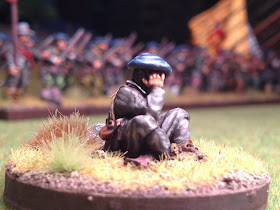Eureka Miniatures Cavalry - sold as Gordon Horse but like most figures in this period they work well with most of the armies. I like these guys as the horses are pretty placid compared to the Perry ones.
Standard is conjectural but is taken to represent the one from Campbell of Lawers Troop. Motto and heraldic boar both feature in various sigils and crests from this branch of the Campbells. Worth noting that these guys weren't the usual Argylle Campbells, rather they were raised in Auchterarder, at the head of Loch Tay under the shadow of Ben Lawers.
The one draw back with the Eureka figures is getting the figures to sit well on the horses - was a real struggle getting them on and even then they seem to be sitting like the have a bad dose of the Duke's (again you'll need someone from Scotland to translate that :-)).











































































